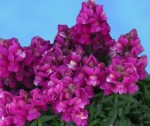 Children and adults alike love snapdragons. Their common name comes from the fact that when a floret is squeezed on its sides, it opens and closes its dragon’s-like mouth. Look closely and you will even see the dragon’s tongue. The botanical name Antirrhinum comes from Greek words meaning nose-like and refers to the shape of the seed pods. Snapdragons are cool weather plants and bloom best in the spring and fall but are available year round in the florist trade.
Children and adults alike love snapdragons. Their common name comes from the fact that when a floret is squeezed on its sides, it opens and closes its dragon’s-like mouth. Look closely and you will even see the dragon’s tongue. The botanical name Antirrhinum comes from Greek words meaning nose-like and refers to the shape of the seed pods. Snapdragons are cool weather plants and bloom best in the spring and fall but are available year round in the florist trade.
Snapdragons are native to the Mediterranean area but came to America in colonial times and were planted in Thomas Jefferson’s childhood home and later at Monticello. The British garden designer and water colorist Gertrude Jekyll used snapdragons extensively in her garden designs and by the 1950s they were among the top five favorite cut flowers. Today tall varieties are grown commercially in greenhouses in North America, South American and Europe and are available as a cut flower year round.
Snapdragons may be white, ivory, pink, red, magenta, burgundy, purple, lavender, yellow, orange, salmons, or bicolored. They should be cut or purchased when the lower lorets are fully open and the upper florets are showing color. They are very ethylene sensitive and should be processed with silver thiosulfate (STS)or other ethylene blocker for best vase life. If you buy from a florist, this will probably have been done but if you cut stems from your own garden be aware that the vase life of your stems may be significantly shortened. After STS processing (or cutting in the garden) cut the stems under water, remove the lower leaves that will be below the water line, and place in a solution of floral food. If flowers are to be stored, place in a cool area (between 32o and 35o F is best) in a darkened place to reduce fading. Make sure that the stems are upright in the bucket as they are geotropic (respond to gravity) and will curve upward if tilted for any length of time. Removing the top bud may deter the curving of the stem. Watch the water level carefully as snapdragons drink a lot of water and should not be allowed to dry out. Pick off florets as they fade to maintain a fresh appearance. With optimum care and handling, they should have a vase life of 5-8 days.
With 18-36″ long snaps, snapdragons can provide a strong linear element in a design. The ruffled appearance of the flowers adds textural interest and is especially attractive in wedding work. Individual florets can be glued into corsages, hair pieces, and boutonnieres. In the language of flowers they stand for presumption and can mean “No!”, or “you are dazzling but dangerous.”
